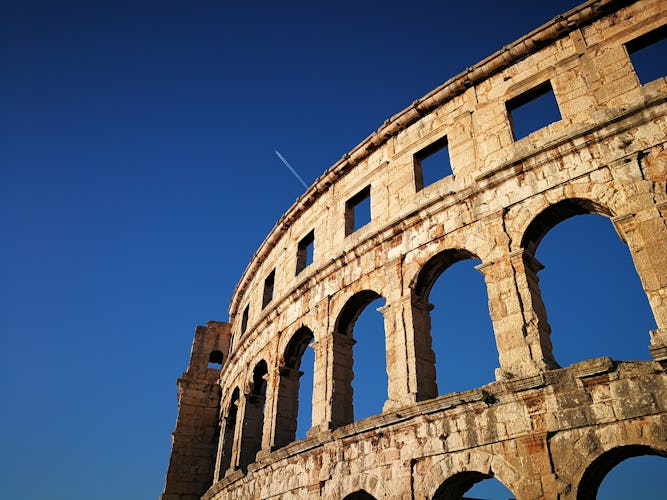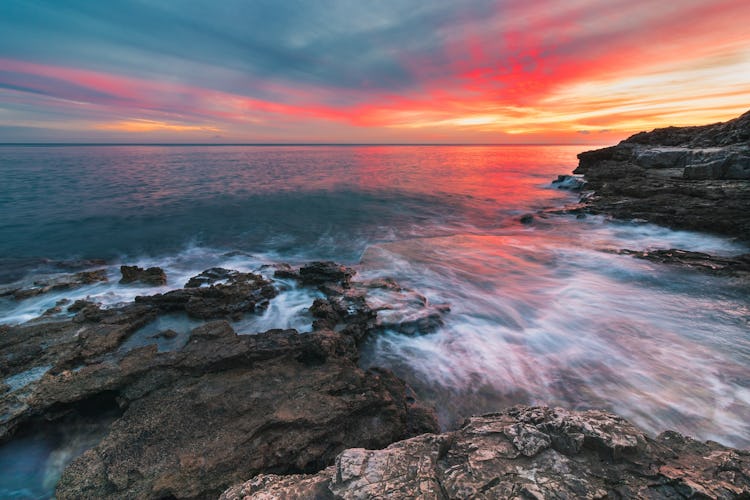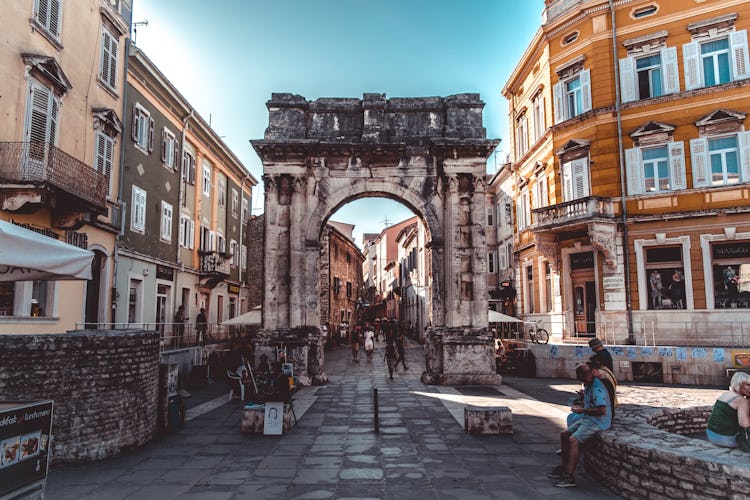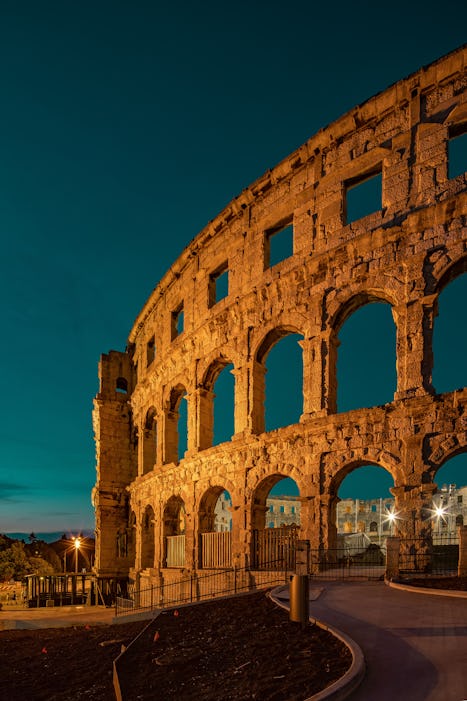Let us help you plan the perfect sailing trip
Provide your travel details, receive free offer and enjoy your holiday!
Pula Croatia
The Istrian Peninsula has become one of the most luxurious travel destinations on the Adriatic coast in the past couple of years. Holidays to Pula and Istria are becoming increasingly popular. Pula has a lot to offer those who want to get a feel for what Istria is like historically, culturally and culinary. The best way to explore Pula’s history is through the city’s old quarter of narrow streets, lined with Medieval and Renaissance buildings. The walkways are still paved with ancient Roman paving stones and lead to one Roman ruin after another including the Colosseum, the Temple of Augustus, the Triumphal Arch of Sergius and The Old Roman Forum.

Pula is a seafront city on Croatia’s Istrian Peninsula. Pula is best known for its rich Roman architectural legacy of surviving ancient buildings. Amongst them are a 1st century amphitheatre where you can experience the thrill of the arena and the gladiators, and the 6th largest Roman Colosseum in the World. Pula has a rich history dating back to the 10th century BC and is best known for its many Roman ruins which have withstood throughout history. For a more modern experience you can visit Flanaticka Street, where you can find some high street shops and restaurants.
Relax at any of the beautiful Pula beaches
Seagull’s Rocks beach (Galebove stijene) is one of the beaches near Pula located in Stoja, one of Pula’s neighborhoods, and it has a breathtaking view of the open sea. The adventurers will love the rocky beach with high cliffs suitable for jumping in the water. The beach is also known for several hidden caves which you can explore. It is a popular spot for divers who take advantage of the clear waters for underwater photo-shoots. Pets are allowed on the beach.
Ambrela Beach Pula, located in the small St John Cove, between Saccorgiana Beach and Hotel Brioni, is covered with pebbles and boulders. Native holm oak trees surround the beach, creating the perfect shade to rest after swimming in the clear blue water. Ambrela Beach is very popular among the local population and guests because of its easy entrance into the sea, making it convenient for families with kids as well.
Lighthouse Beach Pula is located near Cape Verudica on Verudela Peninsula in Pula. The Apple, a small cliff in the sea named after its apple-like shape is the main attraction of the beach. The beach was named after Verudica Lighthouse built in 1877. There is a legend about buried gold under the lighthouse that the Roman Emperor Vespasian hid.
Golden Rocks Beach (Zlatne stijene) stretches from Soline Cove to Saccorgiana Cove, and it is a part of Brankoras Bay. The beach is located between the two resorts Splendid Golden Rocks Resort and Horizont Golden Rocks Resort. There is a pool bar and a market on the beach, along with some restaurants.
Hawaiian Cove Beach is one of the most popular beaches in Pula, especially among the younger population. It was named Hawaii because of the high waves, similar to those found in Hawaii, formed when the Jugo wind hits the cove. The central part of the beach is covered in pebbles with some rocky boulders. The sides are rocky and of medium height, suitable for jumping into the water.

Štinjan Beach is located in Štinjan Cove near Pula and offers natural beauty, clean sea, thick pine woods and fascinating sunsets. The Štinjan Beach is great for adventure seekers as it has many facilities for a fun and active vacation such as a beach volleyball court, jet skis for hire, an aqua park and parasailing. For those looking for places to party there are also plenty of beach bars along the coast open until the early morning hours.
Sandy Cove Beach (Pješčana Uvala) is one of the few sand beaches in the Pula area. It is suitable for families with kids, and it has a water playground. Beach goers can also rent sunbeds and parasols on the beach. Near the beach there are two beach bars and a few restaurants. Lifeguard services take care of the security.
Enjoy Pula restaurants with Italian, Greek and French influence
Istrian cuisine was influenced by its inhabitants and rulers over the centuries from Italy, Greece and France. However, there are a few traditional Istrian delicacies you should try while visiting. The traditional dishes are truffles, olive oil, mussels, prosciutto, oysters, boškarin (Istrian ox), and a dessert called fritule. The Croatian coast, including Istria, is also well known for its Mediterranean diet, which was included in 2013 on the Representative List of UNESCO’s Intangible Cultural Heritage. The Mediterranean diet, also found in Italy, Spain, Portugal, Greece and Cyprus, involves a set of skills, knowledge, rituals, symbols and traditions surrounding fishing, harvesting, cooking and particularly the sharing and consumption of food. The diet emphasizes the importance of eating together, the values of hospitality, intercultural dialogue and creativity.These form the foundations of the cultural identity of communities throughout the Mediterranean.
Top rated restaurants in Pula
- Tavern Batelina is a top rated seafood restaurant in Pula. The restaurant is a family-run tavern located in Banjole, 6 km south of central Pula, and serves only seafood. Every meal is prepared in the most creative way and there is no menu. You will get a list of specials and the staff will present fresh fish for you to choose from.
- Farabuto is a Mediterranean influenced restaurant in Pula, located 1.5 km southwest of the city center. It offers a stylish décor and beautifully presented daily specials with a well-curated wine list. Don’t miss their specialty chocolate mousse with truffle ice cream dessert. The restaurant also hosts wedding receptions and private events.
- Trattoria Vodnjanka offers simple and hearty local Istrian cuisine. Their brief menu focuses on home cooking and their pasta is made the night before. By the words of the cook, Gina Civitico: ‘We serve only traditional dishes, in a sense very modest and accessible to everyone but always prepared with great care.’
- Milan is a fine dining restaurant within the Milan hotel, located in Stoja. The menu offers seasonal specialties made from local produce. You can choose between various set menus, including a four-course Istrian menu loaded with prosciutto.
- Oasi is a stylish restaurant within the Oasi Boutique Hotel. Its varied menu offers local, international and Mediterranean cuisine along with seafood, clams, shrimp, fish and lobster.
- Ribarska koliba restaurant, once a fisherman’s cottage, is a 100-year-old restaurant which has long preserved its tradition of serving up Mediterranean cuisine and fine Istrian wines in a beautiful setting. It offers two different settings, a historic dining room or a modern rooftop lounge bar. The cook, Alen Turković, combines the essence of the Mediterranean cuisine while providing rich and aromatic flavor, adding his personal touch to each plate.
Unwind with a cocktail at one of Pula's bars
- Caffe Uliks is a charming bar, stuffed with knick-knacks from nineteenth-century Pula. The statue of James Joyce greets you at the very entrance to the bar, which was named after his famous novel. The interior is all about brass, backlit stained glass, dark wood, and maritime motives.
- Cvajner, fully named Kunstkafe – Cvajner, is housed in a former bank on the Forum, which is the main square of the old Roman town center. It is known as Pula’s hippest café. Inside the café you can find the fragments of wall frescoes dated to 1928, painted ceiling beams and works of local artists. The place gets its charm from unmatched furniture, sculptures and an old carriage.
- Bass is a hip bar which occupies the porch of a decaying Habsburg-era mansion. The bar is set between Pula and Verudela, and offers a long list of cocktails and alcoholic drinks on a spacious terrace with wooden benches. On Fridays there is a DJ.
- Scandal Express, a unique train-carriage themed bar, is a popular gathering place among the locals. The bar is located near the theatre at the Giardini end of Flanaticka Street. Since the bar isn’t very spacious, you can often see people gathering on the street in front of the bar.
- Beach & Lounge Bar Zeppelin is located in Saccorgiana bay, near Verudela in Pula. The bar is overlooking the Saccorgiana beach, which means you will be able to enjoy a beautiful sunset with dance music playing in the background. There is a large choice of drinks, as well as an option to rent deck chairs, jet skis and tube-bananas.
Make the most of the nightlife in Pula
- Pietas Julia is a bar on the Pula harbor, located near the Arena. During the summer the club is usually open until 5am at weekends. The nightclub and bar offers a wide selection of cocktails, and the music played here is usually techno, electronic and house. The venue, very popular among both locals and visitors, can hold up to 500 people. The place has two bar areas, a lounge filled with sofas and a big dance floor.
- Club Uljanik is situated by the harbour’s edge in the city center. The popular night club offers various musical events and hosts both live bands and DJ's. The club has been operating since 1962.
- E&D Bistro-Lounge Bar opened in 1997, and is located in Verudela, near Pula. In the summer there are various international DJ appearances. The bar is a great place to relax while sipping sunset cocktails next to the swimming pool. There are also some Mediterranean dishes if you get hungry.
- Rock Café is situated near the Arena in the Pula city center. The bar has been open since the nineties. There is live music playing throughout the week with jazz, blues and Croatian rock cover bands. The interior is dressed in dark wood, old posters, music memorabilia and murals depicting famous rock stars. In the bar you can enjoy your favorite beer while shooting pool or dancing. There are also acoustic sessions held on Saturdays.

Some of our top recommendations for things to do in Pula
- Explore Pula Arena – The 6th largest Roman Colosseum in the World is still in use today during summer film festivals and weekly gladiator shows. The preserved Colosseum is witness to the strong Roman influence in Pula’s history. The three-level Arena was used until the 5th century AD for gladiator fights and other mass spectacles. It could fit more than 26,000 spectators. Below the ground are a series of tunnels where the gladiators and animals awaited their fights. There is a tour of the Pula Colosseum you can take which includes a visit to the attached museum.
- Discover The Old Roman Forum and the Temple of Augustus – admire the Roman architecture while sipping coffee from one of the cafés or having a glass of wine. The Temple of Augustus was built in the 2nd century BC and is dedicated to Roman Emperor Augustus and the goddess Roma. The Temple has been used for different purposes throughout its history: a temple, a church and a granary. You can take a quick tour of the interior for a small fee.
- Stroll Through The Twin Gate – Porta Gemina dates to the mid-2nd century, and is one of the few remaining gates. The old city gates are located near the Arena, and were built to allow more townspeople into the city during gladiator fights and other major events. The Twin Gates are one of the few remaining gates after the city walls were pulled down at the beginning of the 19th century.
- Visit the Triumphal Arch of Sergius – The arch dates to the 1st century BC and marks the edge of the original Roman town. It was built to honor the members of the Sergii family who fought in a battle between Octavian’s Roman army and Mark Antony’s Egyptian/roman army. The Triumphal Arch represents one of the top attractions in Pula, and is decorated with fluted columns and chariots engraved along the top.
- See the Cathedral of The Assumption of The Holy Virgin and the Basilica of St. Mary Formosa – the Roman Cathedral dating from the 5th century AD and the Byzantine chapel dating from the 6-7th century AD. The bell tower of the Roman Cathedral, built in the Venetian Baroque style, dates to the 18th century. The cathedral, built by the Christians during their persecutions, is built in minimalist style and represents an important period in art history.
- Enjoy Croatian Wine – The best known white Croatian wines are Graševina, Pošip and Malvazija; while the best known red Croatian wines are Teran and Plavac Mali. The best way to get to know Croatian wines is visiting some of the well-known Istrian wineries or through wine tasting festivals.
- Taste Istrian traditional dishes – Truffles is the best known and most expensive traditional Istrian food. It is a type of mushroom which grows under the ground and has a strong taste and pungent aroma. Olive oil is widely used in Mediterranean cuisine for cooking and preparing food or as a salad topping. Mussels and Oysters are famous seafood delicacies. Prosciutto and Boškarin (Istrian ox) are the most representative types of meat, along with venison.
Let us help you plan the perfect sailing trip
Provide your travel details, receive free offer and enjoy your holiday!

